

Mexico Map -ZoomSchool.com. Advertisement.
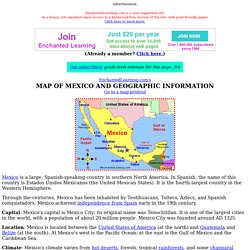
EnchantedLearning.com is a user-supported site. As a bonus, site members have access to a banner-ad-free version of the site, with print-friendly pages.Click here to learn more. (Already a member? Click here.) EnchantedLearning.com'sMAP OF MEXICO AND GEOGRAPHIC INFORMATIONGo to a map printout Mexico is a large, Spanish-speaking country in southern North America. Through the centuries, Mexico has been inhabited by Teotihuacans, Toltecs, Aztecs, and Spanish conquistadors. Capital: Mexico's capital is Mexico City; its original name was Tenochtitlan. Location: Mexico is located between the United States of America (at the north) and Guatemala and Belize (at the south). Climate: Mexico's climate varies from hot deserts, forests, tropical rainforests, and some chapparal (along the northwestern coastline).
Area: Mexico covers almost 2 million square kilometers of land. Related Pages: The Spanish Conquest (1519-1521) Dale Hoyt Palfrey April 21, 1519--the year Ce Acatl (One Reed) by Aztec reckoning-- marked the opening of a short but decisive chapter in Mexico's history.
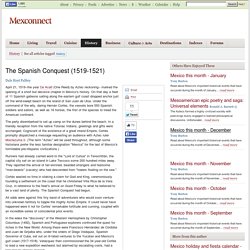
On that day a fleet of 11 Spanish galleons sailing along the eastern gulf coast dropped anchor just off the wind-swept beach on the island of San Juan de Ulúa. Under the command of the wily, daring Hernán Cortés, the vessels bore 550 Spanish soldiers and sailors, as well as 16 horses, the first of the species to tread the American continent. The party disembarked to set up camp on the dunes behind the beach.
In a friendly reception from the native Totonac Indians, greetings and gifts were exchanged. Runners had already carried word to the "Lord of Cuhúa" in Tenochitlán, the capital city set on an island in Lake Texcoco some 200 hundred miles away. All odds were against this tiny band of adventurers who would soon venture into unknown territory to topple the mighty Aztec Empire. MexicanHistory.org Mexican history from ancient times to today. Mexico - History & Culture. MEXICO History and Culture Mexico's historical attractions - from the ancient ruins of the Olmecs, Maya, and Aztec, to the train routes used by the brash and legendary Pancho Villa - rank second only to the beaches of Cancun - and Alcapulco as the prime reason people come.
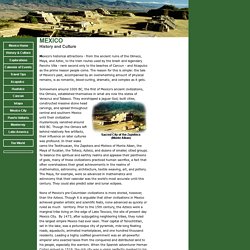
The reason for this is simple: the tale of Mexico's past, accompanied by an overwhelming amount of physical remains, is as romantic, blood-curling, dramatic, and complex as it gets. Somewhere around 1000 BC, the first of Mexico's ancient civilizations, the Olmecs, established themselves in what are now the states of Veracruz and Tabasco. They worshipped a jaguar God, built cities, constructed massive stone head carvings, and spread throughout central and southern Mexico until their civilization mysteriously vanished around 400 BC.
Though the Olmecs left behind relatively few artifacts, their influence on later cultures was profound. History and Meaning of the Mexican Flag. Mexico's Flag The Mexican flag consists of three vertical bands in green, white and red, with the Mexican coat of arms (which portrays an eagle on a prickly pear cactus with a snake in its beak and talons) in the center of the white band.
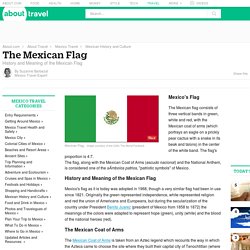
The flag's proportion is 4:7. The flag, along with the Mexican Coat of Arms (escudo nacional) and the National Anthem, is considered one of the sÃmbolos patrios, "patriotic symbols" of Mexico. History and Meaning of the Mexican Flag Mexico's flag as it is today was adopted in 1968, though a very similar flag had been in use since 1821.
The Mexican Coat of Arms The Mexican Coat of Arms is taken from an Aztec legend which recounts the way in which the Aztecs came to choose the site where they built their capital city of Tenochtitlan (where Mexico City stands today). Protocol When the Mexican flag is displayed, Mexicans stand at attention with their right arm placed in a salute over their chests with the palm facing downward. Flag Day. Mexico Education System. Primary Education “Primeria” education, in its current form became compulsory in 2009, and runs from grade one through grade six, for students aged 6 – 12 years.
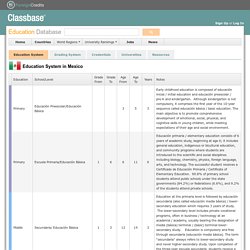
The Secretariat of Public Education (SEP) officially determines primary school a part of ‘Basic Education’, making it free of charge, with one year of mandatory pre-school education. SEP standardizes curriculum content for public and private schools, which includes Spanish, mathematics, natural sciences, history, geography, art, and physical education. The National Institute for Assessment of Education monitors standards and provides quality control. Middle Education Secondary Education in Mexico is organized into two stages: Lower-Secondary Education (Educación Secundaria Básica), grades 7-9, and Upper-Secondary Education (Educación Media Superior), grades 10-12. Secondary Education.